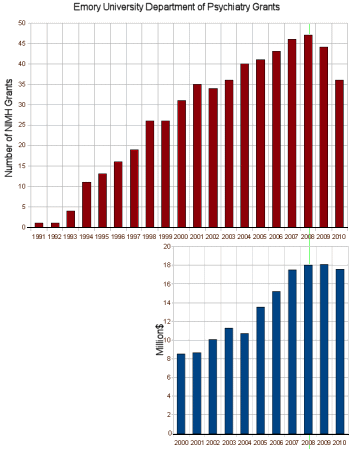I’ve spent no small amount of time raling about the invasion of the Pharmaceutical Industry into Academic Medicine, specifically at Emory University where I trained and worked for some time. The Chairman, Dr. Charles Nemeroff, was relieved of his Chair in 2008 because of repeated Conflict of Interest violations. Since then, he has moved on to become the Chairman at the Miller School of Medicine in Miami. You might wonder why Miami would recruit a tarnished person, or why Emory put up with his antics so long. That question has an answer. Dr. Nemeroff came to Emory in 1991. At that time, the Department at Emory had no National Institute of Mental Health Grants. In the NIH/NIMH database, the funding amounts for grants only goes back 10 years, so I’ve shown the total number of grants above for the whole period and added the total funding below for the last decade:

PREDICTORS OF ANTIDEPRESSANT TREATMENT RESPONSE: THE EMORY CIDAR
IMAGING PREDICTORS OF TREATMENT RESPONSE FOR DEPRESSION
EMORY-MSSM-GSK-NIMH COLLABORATIVE MOOD AND ANXIETY DISORDERS INITIATIVE
THE ROLE OF SEPTAL V1AR DENSITY IN REGULATING SOCIAL BEHAVIOR
NEUROIMMUNE MECHANISMS OF GLUCOCORTICOID RESISTANCE
DOPAMINERGIC MECHANISMS OF CYTOKINE-INDUCED BEHAVIORAL CHANGE
IL-2 NEUROPSYCHIATRIC SYMPTOMS: MECHANISMS, PREVENTION
BIPOLAR DISORDER IN PREGNANCY: PREDICTORS OF MORBIDITY
This little side trip was stimulated by a comment a colleague made at a meeting this last weekend, "The Department grew and flowered, but I’m not sure the patient care changed all that much." I would’ve gone further and said that all this focus on drugs and hard science was at the expense of psychotherapy and careful diagnostic evaluations. In fact, I’m sure of that. What’s good for the University and the Department’s reputation is not necessarily good for the students and patients.
Hi,
Speaking of Nemeroff, I thought you’d appreciate this disclosure list:
http://clinpsyc.blogspot.com/2010/04/charles-nemeroff-consultant.html